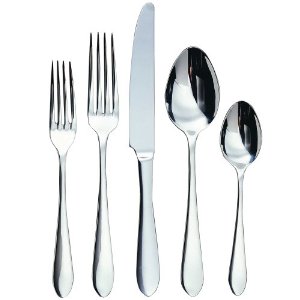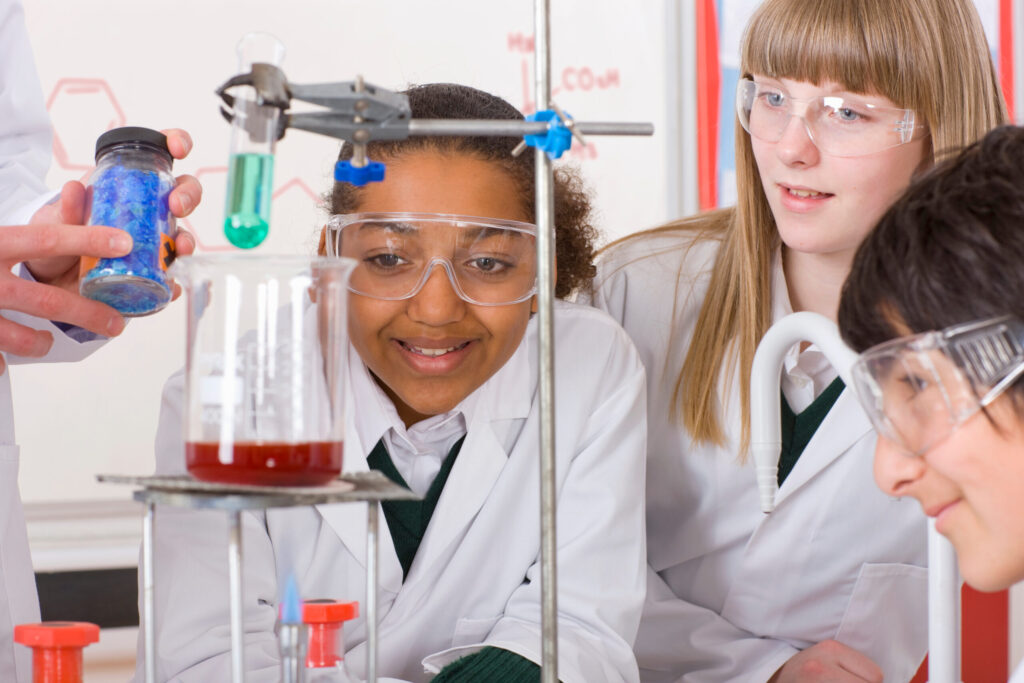What did you use to eat your last meal? You probably used a knife, fork and perhaps a spoon. What were they made from? There’s a good chance that it was stainless steel. What is ‘stainless steel’?
Steel is a metal that is largely made up of iron. There are lots of types of steel used for many different purposes. ‘Stainless’ means that the steel doesn’t rust and it isn’t attacked by acids or other chemicals. If you put a dirty stainless steel knife in the dishwasher it comes out gleaming and clean regardless of how many times you do it.
 There was a lot of demand for a steel that was stainless but it wasn’t invented or discovered until one hundred years ago. Iron had been used for thousands of years but the industrial revolution relied on it. Iron was used for the boilers in steam engines, for the girders in bridges and buildings, for the hulls of ships and the barrels of guns. It was also made into everyday objects such as nails, cutlery and pots and pans. During the nineteenth century different types of steel were developed. Steel is iron mixed with other substances such as carbon, phosphorus and other metals. Some steels are harder than others, have higher melting points, or are stronger or more malleable. Each type of steel has its uses. Unfortunately most of them rust or react with chemicals.
There was a lot of demand for a steel that was stainless but it wasn’t invented or discovered until one hundred years ago. Iron had been used for thousands of years but the industrial revolution relied on it. Iron was used for the boilers in steam engines, for the girders in bridges and buildings, for the hulls of ships and the barrels of guns. It was also made into everyday objects such as nails, cutlery and pots and pans. During the nineteenth century different types of steel were developed. Steel is iron mixed with other substances such as carbon, phosphorus and other metals. Some steels are harder than others, have higher melting points, or are stronger or more malleable. Each type of steel has its uses. Unfortunately most of them rust or react with chemicals.
Harry Brearley was an expert on steel. He was the son of a steelworker in one of the many steelworks in Sheffield. In 1883, when he was twelve years old, Harry left school and began work in a steelworks as a cellar lad, that is moving stuff around and brushing up dirt. A couple of years later he got a job as a bottle-washer in the company’s laboratory. Harry was hardworking and he studied hard at metallurgy, the study of steels and other metals, and so he worked his way up to become a researcher. He was given the chance to run a new laboratory opened jointly by the companies of Firth and Brown in Sheffield. In the years before the First World War began in 1914 many companies were involved in making arms. Harry was given the problem of making gun barrels last longer. He tried making new types of steel. Adding chromium to the iron made the steel harder. In August 1913 he produced a steel with about 12% chromium and very little carbon that was hard and a shiny silver in colour.
To examine the structure of metals metallurgists cut and polish a sample and then etch it with nitric acid before looking at the surface with a microscope. Harry found that his new steel did not react with nitric acid, nor did it rust when left in damp air. His employers were not interested at first but one of the companies in Sheffield that made cutlery began to use the new alloy. At first Harry just called it rustless steel but a friend suggested ‘stainless steel’ as a more catchy name.
Other people across the industrialised world had experimented with chromium steels and so it is difficult to say that Brearley invented stainless steel. His steel did however have the more than 10% chromium necessary for it to stay rust free and it was Brearley’s efforts that made stainless steel useful and popular. Brearley became a director of a stainless steel manufacturer and died in 1948, a wealthy man.
Stainless steel is an alloy. This means it is a mixture of metals, but unlike mixtures such as salt and sand it is difficult to separate. The atoms of chromium replace atoms of iron in the crystal structure of the metal. This makes the metal hard and strong. The chromium atoms on the surface react with oxygen in the air to form a coating of chromium oxide that protects the iron from rusting. The layer of chromium oxide is so thin, however, that light passes through it and the surface looks shiny. Although a metal it is not a very good electrical conductor and despite being mainly iron some types of stainless steel are not magnetic.
Stainless steel is used wherever its hardness and resistance to corrosion are useful. As well as in cutlery, crockery and surgical knives, it is used in buildings, in reaction vessels and pipes in chemical factories, in cars and aircraft. It was used for the body of the DeLorean car used in the film, Back to the Future. While time travel may not be possible, stainless steel will be a superstuff for many years to come.
Activities
- What materials have been used to make cutlery? Why is cutlery today very often made using stainless steel?
- What effect do you think stainless steel has had on everyday life?
- Explain why you will not find steel in the Periodic Table.
- Most types of steel are harder and stiffer than pure iron. Explain why adding another metal has this effect on iron.
- Suggest why it has been difficult to prove that Harry Brearley is the inventor of stainless steel. (2013 is being celebrated as the centenary of its discovery).
- Explain how a relatively small amount of chromium stops the iron in stainless steel from rusting.
- There haven’t been many cars made from stainless steel (the DeLorean was a failure). Suggest reasons why stainless steel is not used generally for car bodies.
- Make a list of the uses of stainless steel. Do you think it is justified to call it a superstuff?
Bibliography
The Discovery of Stainless Steel: http://www.bssa.org.uk/about_stainless_steel.php?id=31
Harry Brearley: http://www.museums-sheffield.org.uk/project-archive/burngreave-voices/BrearleyH.html
Harry Brearley and stainless steel: http://www.cutlers-hallamshire.org.uk/home/brearley-and-stainless-steel
Peter Ellis



